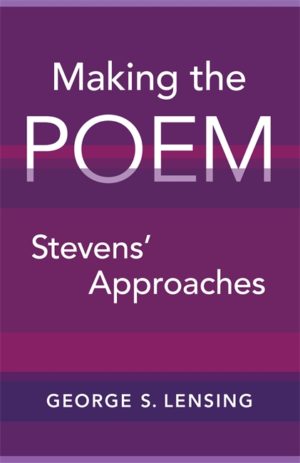 The name of the American poet Wallace Stevens (1879-1955) is not as familiar as other poets of his generation like Robert Frost and E.E. Cummings. He’s best known, not just for being a poet, but also a successful business man in Hartford, CT: vice-president of the Hartford Accident and Indemnity Co. He somehow managed to excel in both poetry and business. You might recognize some of the titles of his poems like “Thirteen Ways of Looking at a Blackbird” or “The Emperor of Ice-Cream.” In the sixty years or so since his death, his reputation as a major poet of “modernism” increasingly places his reputation with that of Frost, T.S. Eliot and W.B. Yeats. I hope that my book, Making the Poem: Stevens’ Approaches, can contribute to that awakening interest.
The name of the American poet Wallace Stevens (1879-1955) is not as familiar as other poets of his generation like Robert Frost and E.E. Cummings. He’s best known, not just for being a poet, but also a successful business man in Hartford, CT: vice-president of the Hartford Accident and Indemnity Co. He somehow managed to excel in both poetry and business. You might recognize some of the titles of his poems like “Thirteen Ways of Looking at a Blackbird” or “The Emperor of Ice-Cream.” In the sixty years or so since his death, his reputation as a major poet of “modernism” increasingly places his reputation with that of Frost, T.S. Eliot and W.B. Yeats. I hope that my book, Making the Poem: Stevens’ Approaches, can contribute to that awakening interest.
Stevens has been a lifelong interest on my part, and this book is the third written by me on this poet, all published by LSU Press, and the first two are still available in paperback editions. For readers less familiar with Stevens, you could begin by looking at the second of the three books, Wallace Stevens and the Seasons. The four seasons constitute the major metaphor running through his poetry. To understand how Stevens uses the seasons provides an important grounding for reading more widely in his work. You could look at the “Introduction,” especially pages 1-9, and then a discussion of one poem from each season, such as “Metamorphosis” for autumn (pp. 108-111); “The Snow Man” for winter (pp. 131-144); “The World as Meditation” for spring (pp. 192-203); and the beautiful “Credences of Summer,” for that season (pp. 272-287).
I especially recommend the new book, however, if you are interested in questions like these (each containing a separate chapter): How does a vacation trip through the Panama Canal, duly recorded in his wife’s journal, become a poem (“Sea Surface Full of Clouds”)? How does one of his two or three major poems (“The Idea of Order at Key West”) come to be written and how is it organized? How do international crises and politics figure into his poetry? How does his particular style of writing as a “spoken” art form make a contribution to his art? And, finally, how does his audience evolve and emerge, especially outside the United States? These essays can be read as separate essays or all together.
Other recommended books:
- Eleanor Cook, A Reader’s Guide to Wallace Stevens (Princeton University Press, 2009).
- John Serio, “Introduction,” Wallace Stevens: Selected Poems (Alfred A. Knopf, 2011): pp. xi-xxii.
- John Serio, ed. The Cambridge Companion to Wallace Stevens (Cambridge University Press, 2007).
- Joseph N. Riddel. The Clairvoyant Eye: The Poetry and Poetics of Wallace Stevens. (LSU Press, 1965)
- Peter Brazeau. Parts of a World: Wallace Stevens Remembered. (Random House, 1983).
George S. Lensing is Mann Family Distinguished Professor of English Emeritus at the University of North Carolina at Chapel Hill and the author of Wallace Stevens: A Poet’s Growth and Wallace Stevens and the Seasons.


